The installation process for the beta version is different from the installation process for the production version. You should begin on the main Installation Instructions page but stop after you install OraHost and register it.
Follow the instructions here to install the beta version of the browser extension.
For general information about beta testing, see the Information for Beta Testers page.
Installing the Browser Extension
Install the beta version of the browser extension after installing the host component. The browser extension is available for the following browsers. You may install ORA in more than one browser if you use multiple browsers or want to do so for testing purposes.
In each case, you do not install the extension by using an add-ons site or web store. Installing an extension for beta testing uses the ability of the browser to load an extension that is on your own PC. The ORA Host installer has placed two copies of ORA on your computer, a Chrome version and a Firefox version. The Chrome version is also used for Edge and Opera.
See the browser-specific instructions below.
Chrome
- Start Chrome.
- Go to the Extensions page. One easy way is to copy
chrome://extensions/and paste it into the address bar. - If the "Developer mode" switch in the upper-right is off, turn it on:
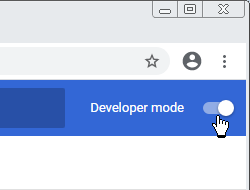
Developer mode is on - If this is your first time installing the beta version of the browser extension, click the [Load unpacked] button.
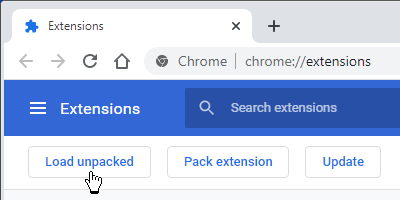
[Load unpacked] button - Navigate to the
c:\Program Files (x86)\Ora Host 1b\Chromefolder and click [Select Folder].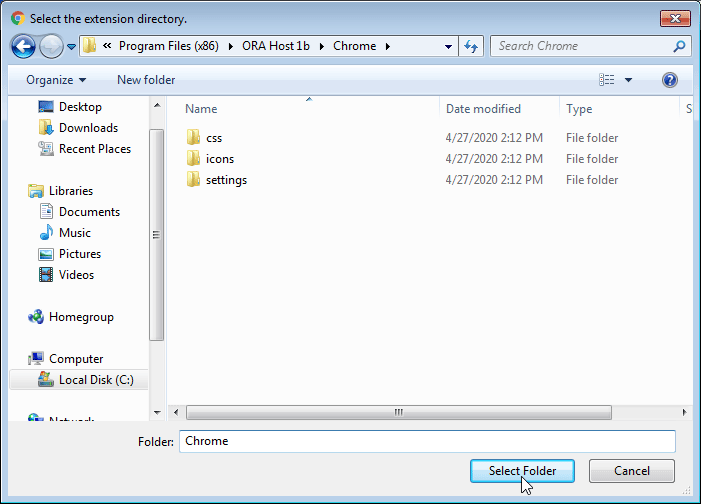
Select the folder - Chrome will load the ORA browser extension and you will see it somewhere in your list of extensions.
- The ORA icon will now appear in the upper-right of your Chrome window. it is highlighted in red below.

The ORA icon - Click the ORA icon and then continue with the instructions below in the OraSettings section.
After installing the beta version of the ORA extension, or any other local extension, Chrome may warn you about it when you start the browser. A message panel will appear under the extension icons in the upper-right of your browser. You will have to close it.
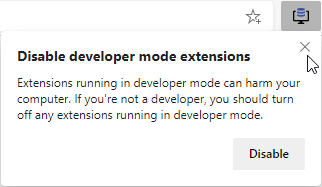
Edge
ORA is compatible with the Chromium-based version of Edge only so you must use Edge version 80.0.361.111 or greater.
Edge supports Chrome extensions and you install the Chrome version of the ORA extension in Edge. The word Chrome appears in these instructions and that is not a mistake.
- Start Edge.
- Go to the Extensions page. One easy way is to copy
edge://extensions/and paste it into the address bar. - If the "Developer mode" switch in the lower-left is off, turn it on:
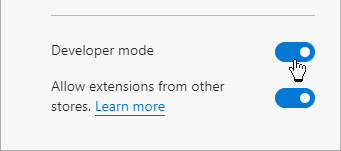
Developer mode is on - If this is your first time installing the beta version of the browser extension, click the [Load unpacked] icon in the upper-right.
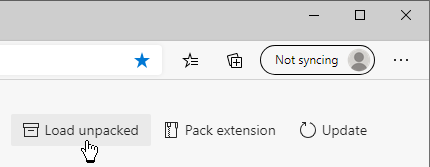
[Load unpacked] icon - Navigate to the
c:\Program Files (x86)\Ora Host 1b\Chromefolder and click [Select Folder].
Select the folder - Edge will load the ORA browser extension and you will see it somewhere in your list of extensions.
- The ORA icon will now appear in the upper-right of your Edge window. It is highlighted in red below.
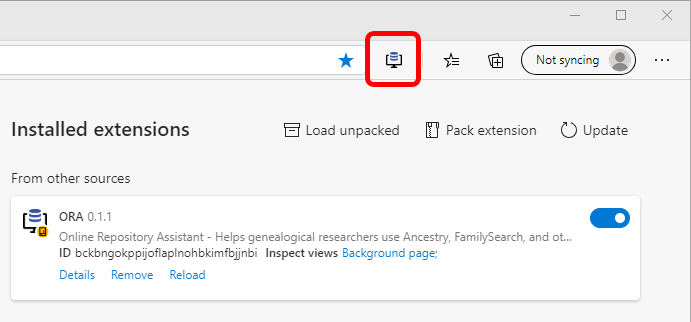
The ORA icon - Click the ORA icon and then continue with the instructions below in the OraSettings section.
After installing the beta version of the ORA extension, or any other local extension, Edge may warn you about it when you start the browser. A message panel will appear under the extension icons in the upper-right of your browser. You will have to close it.

Firefox
- Start Firefox.
- Go to the Extensions page: about:debugging#/runtime/this-firefox
- Click the [Load Temporary Add-on...] button above the extension list.

[Load Temporary Add-on...] button - Navigate to the
c:\Program Files (x86)\Ora Host 1b\Firefoxfolder, click themanifest.jsonfile, and click [Open].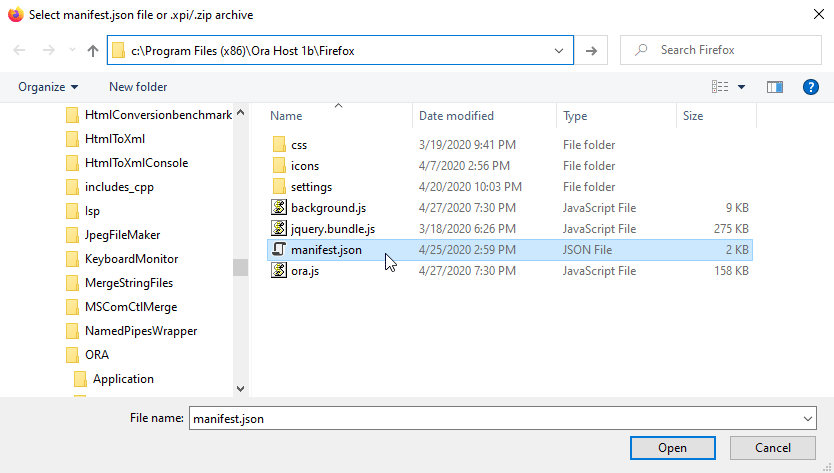
Select the manifest.json file - Firefox will load the ORA browser extension and you will see it in the list of temporary extensions.
- The ORA icon will now appear in the upper-right of your Firefox window. It is highlighted in red below.
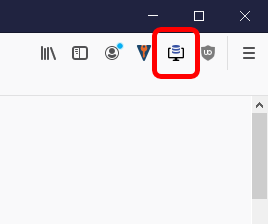
The ORA icon - Click the ORA icon and then continue with the instructions below in the OraSettings section.
Unlike the other browsers, Firefox will not load the ORA extension when you restart the browser. You will have to load it again. I suggest you add a bookmark for the about:debugging#/runtime/this-firefox page. When you click the [Load Temporary Add-on...] button, Firefox remembers the location of the last add-on you added, so you don't have to navigate anywhere. The process is pretty painless, but more work than the other browsers.
Opera
Opera supports Chrome extensions and you install the Chrome version of the ORA extension in Opera. The word Chrome appears in these instructions and that is not a mistake.
- Start Opera.
- Go to the Extensions page. One easy way is to copy
opera://extensions/and paste it into the address bar. - If the "Developer mode" switch in the upper-right is off, turn it on:
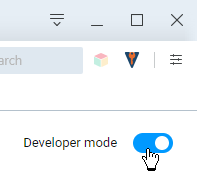
Developer mode is on - If this is your first time installing the beta version of the browser extension, click the [Load unpacked] icon in the upper-right.

[Load unpacked] button - Navigate to the
c:\Program Files (x86)\Ora Host 1b\Chromefolder and click [Select Folder].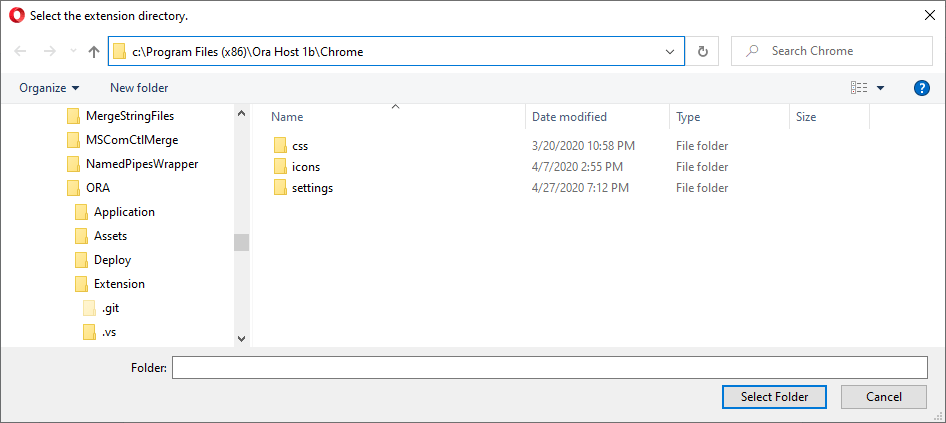
Select the folder - Opera will load the ORA browser extension and you will see it somewhere in your list of extensions.
- The ORA icon will now appear in the upper-right of your Opera window. It is highlighted in red below.
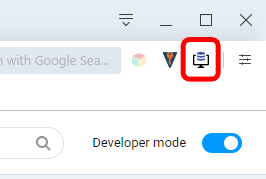
The ORA icon - Click the ORA icon and then continue with the instructions below in the OraSettings section.
After installing the beta version of the ORA extension, or any other local extension, Opera may warn you about it each time you start the browser. A message panel will appear under the extension icons in the upper-right of your browser. You will have to close it.

OraSettings
When you click the ORA icon near the top-right of the browser window, the browser will open the OraSettings page in a new tab. Make any changes or use the other controls as desired.
When you open OraSettings and you are using a beta version, you'll see "(BETA)" in the heading:

It's important to know when you are using the beta version because the production data and the beta data are separate.